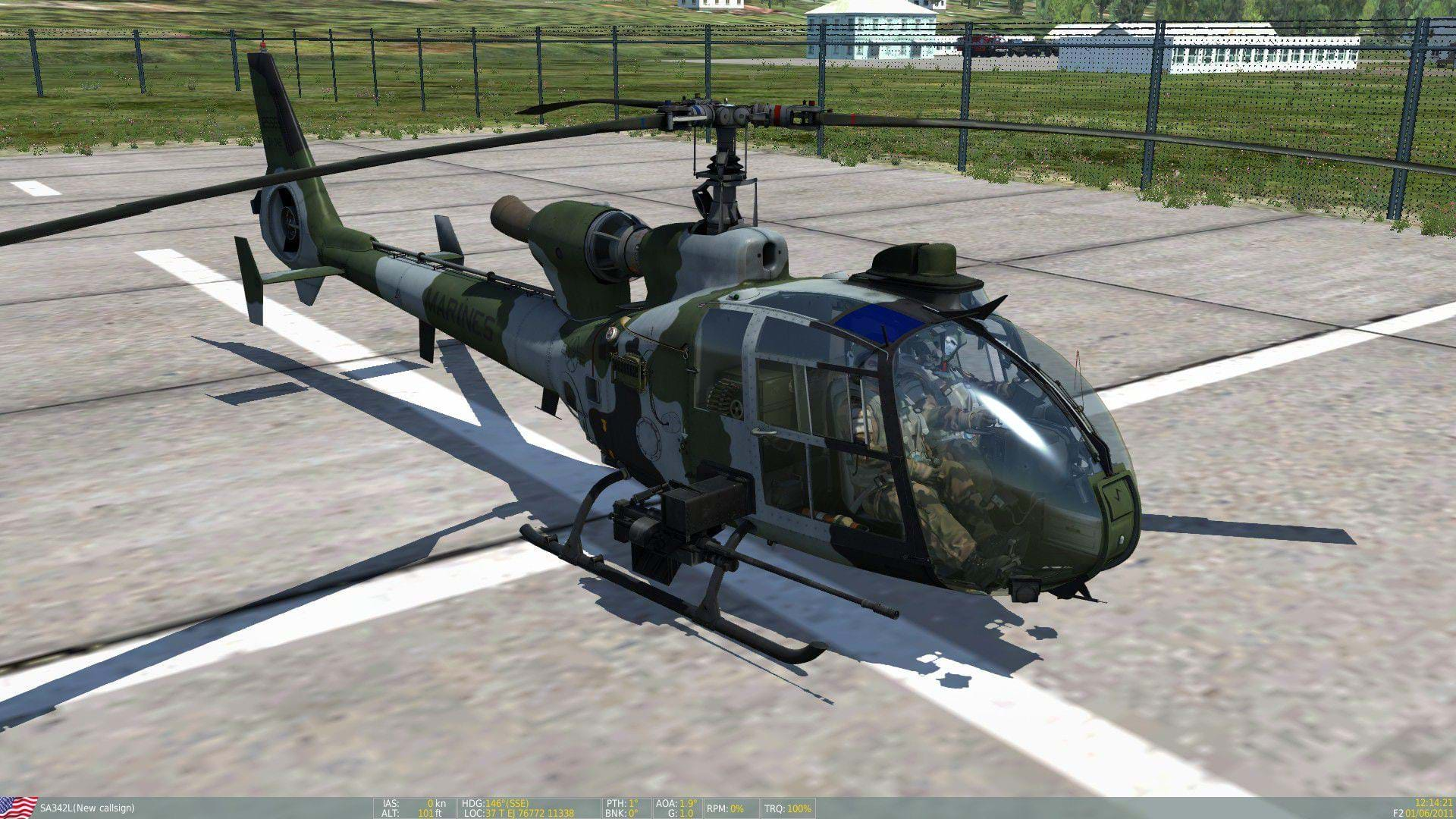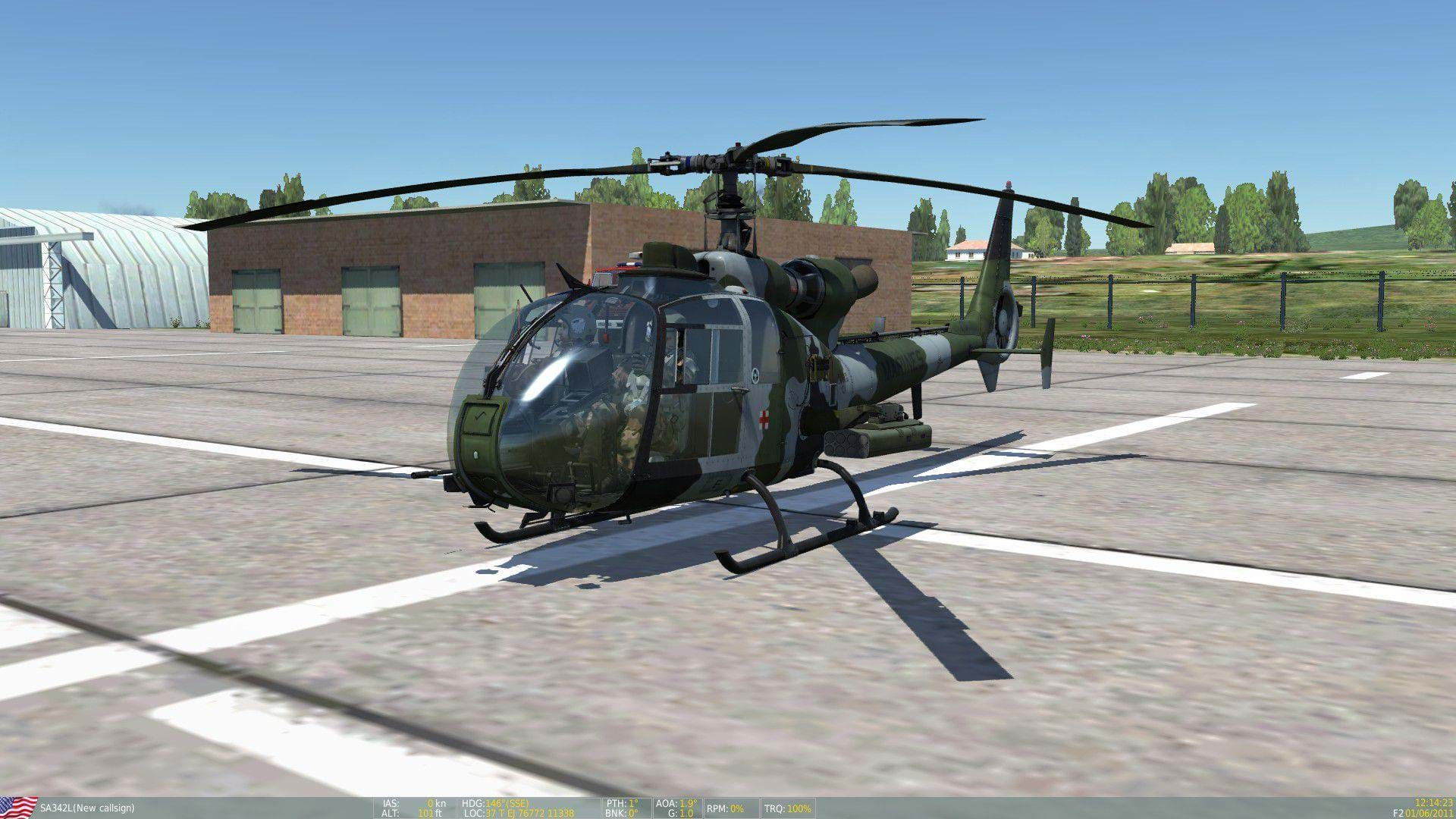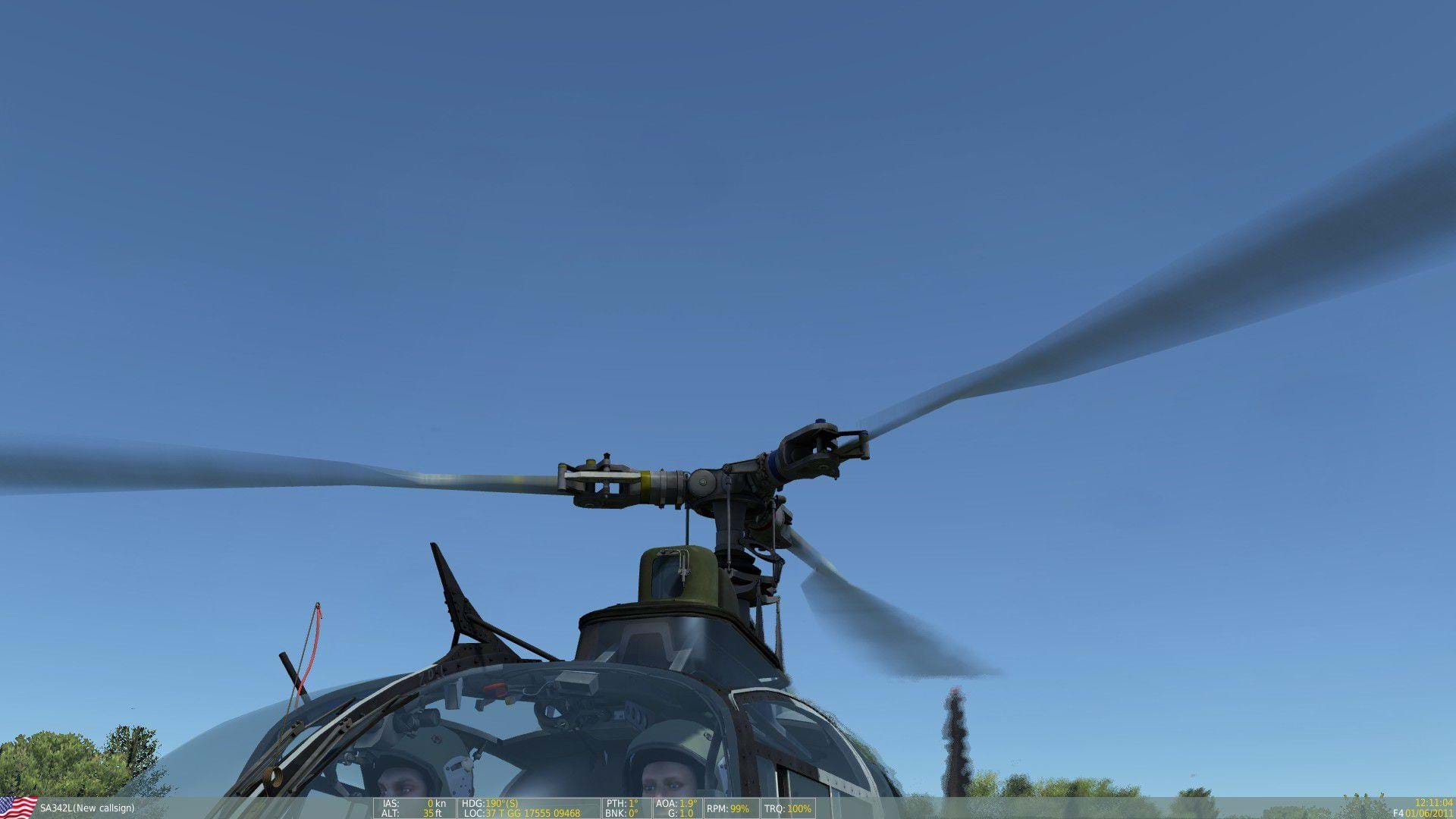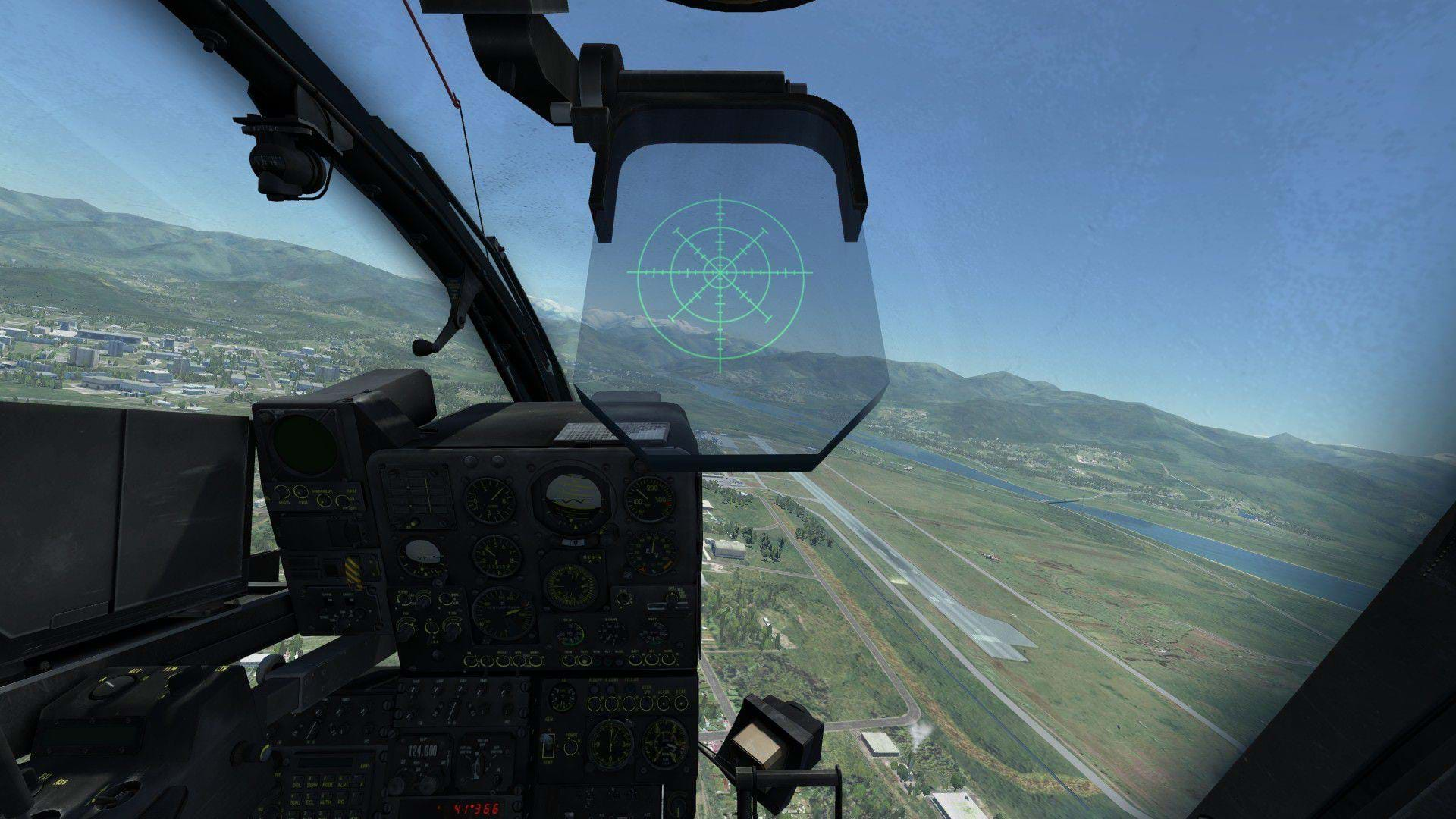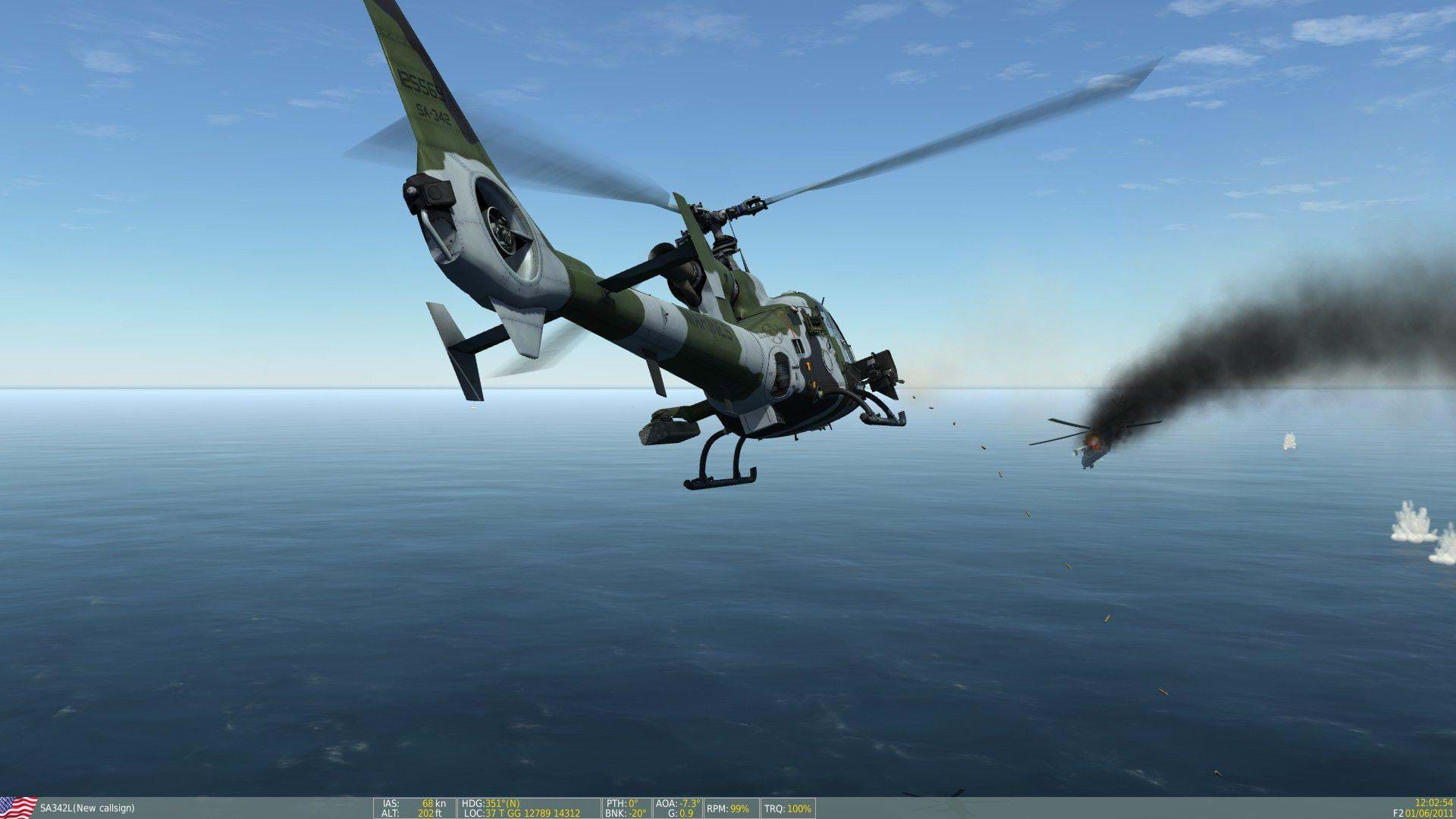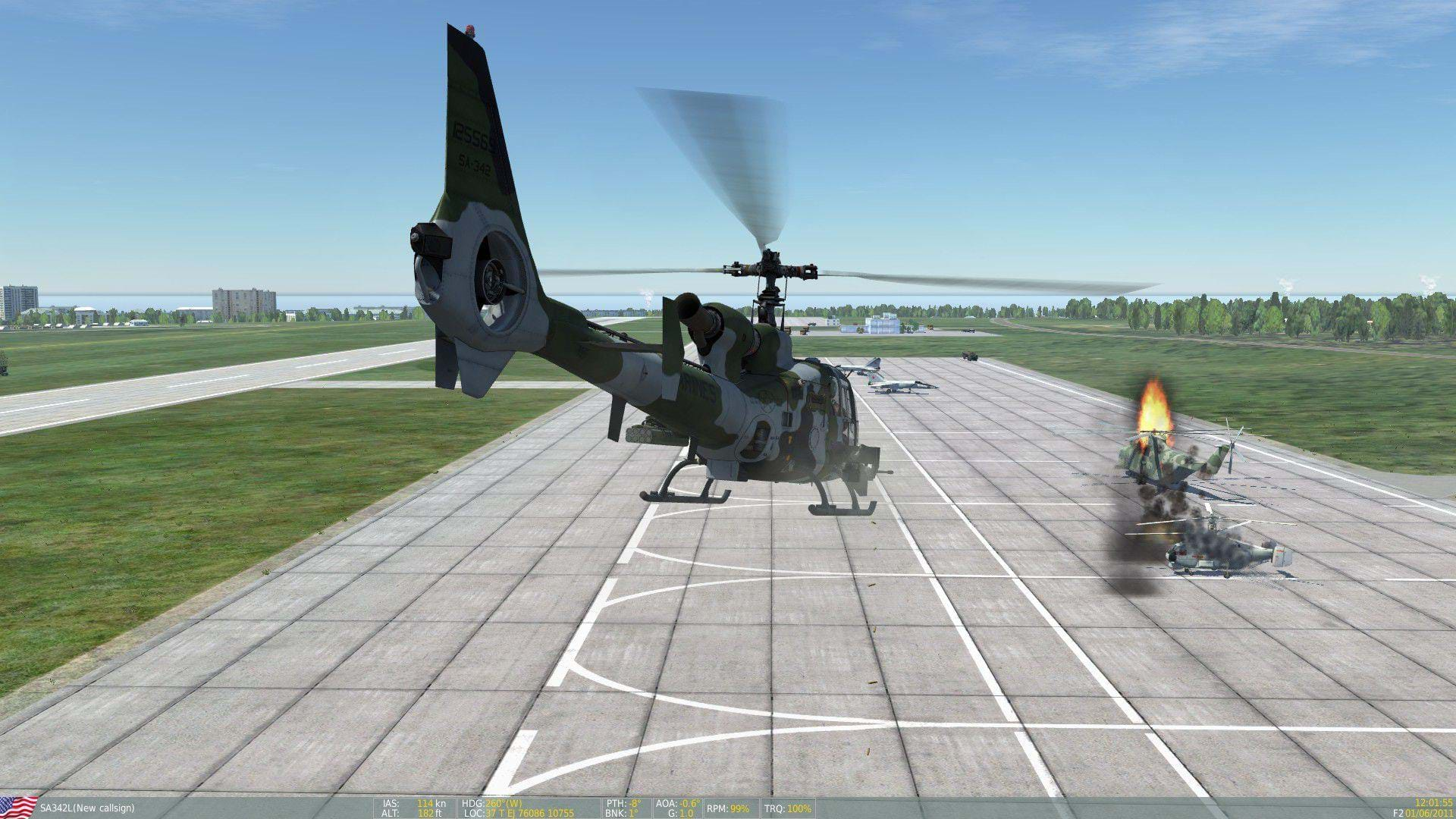A few days ago Polychop released their SA342L model, and I couldn’t wait to get it in the air and see what they had done. This will be an update to the earlier review of Polychop’s SA342 that you can also find here at HeliSimmer.
Installation
As of the writing of this review, the SA342L is a free update for the SA342M. It’s also currently only available for DCS world version 1.5.4. So, if you don’t have that yet, you’ll have to go to the DCS website and download it. As of this writing, it’s not clear when the L model will make it to DCS 2.0
Second Look
The L-model Gazelle, features two new weapon systems, the GIAT M621 20mm Cannon, and The SNEB 68 EAP unguided rocket system, even though the L model is still a work in progress, the exterior and interior visual models are very well done. Details like the ammunition magazine and feed chute are modeled very nicely.
The 8 shot rocket pod is rectangular in shape, which seems to be the preferred style for European attack helicopters. I’m not very familiar with this rocket system, but looks like each rocket tube has a frangible cover for both the front and back. Either that, or Polychop hasn’t gotten around to modeling the unfired rockets in the tube.
It also features a new roof mounted daytime only sighting system which is much smaller than that of the M model.
Weapon systems
The cockpit of the SA342L looks very similar to the M model, with the exception of the added weapons control panel on the center console. This allows the pilot to power the weapons systems, and action each weapon system individually.
The L model also includes a retractable weapons sight on the pilot side, with a unique target reticule for the rockets, and for the cannon.
While I’ve never fired a rocket from a Gazelle, I have fired Hundreds of rockets from helicopters. For the most part, most folding fin aerial rockets behave in a similar fashion. The ballistic solutions and aiming techniques vary from rocket type to rocket type, but once they are aimed, fired, and in the air you can generally expect the same thing from any point detonating fused rocket. The rocket modeling of the L model in flight is pretty good. It’s about as close to realistic as anyone else has gotten for a desktop simulator so far. However, there is one thing that Polychop’s rockets seem to do that no real life rocket, of any type or model that I’ve ever fired has ever done. The rockets in this model seem to have a recoil effect on the helicopter.
Recoil really isn’t present when firing rockets in real life. Now, for smaller helicopters, you can expect the aircraft's stability to be disturbed by the rocket launch, but that’s mostly due to the sudden difference in air pressure as the rocket zips by the fuselage at close to twice the speed of sound. Polychop’s SA342L has distinct recoil to each rocket launch that is nothing like I’ve ever experienced in 10 years of aerial gunnery. Each time you pull the trigger to fire a rocket, the nose of the aircraft gets pushed to the side of the rocket pod. You might be forgiven for thinking that this is because the rockets are only fired from one side, not in pairs like on the UH-1H. Well, there’s some physics that show this isn’t the case.
If you look at a rocket pod, whether it is U.S, Russian or European built, mounted on a helicopter or a fixed wing aircraft, you’ll notice that they are designed with the back ends open. This allows the exhaust plume from the rocket motor to safely go out of the back of the tube. Otherwise, in a closed tube, the rapidly expanding burning gasses of the rocket exhaust plume would be trapped in the tube, potentially causing damage to the tube and the rocket. A closed tube is really the only way a successfully fired rocket would produce any sort of recoil because the thrust of the rocket motor would be pushing against the sealed back of the rocket tube. Sometimes, a frangible cover is placed at the front and back ends of the pods, but this is just to keep out dirt and other debris that might damage or inhibit the launch, or in some cases to reduce drag. Those covers are always designed to be blown out by the pressure of the exhaust plume of the rocket motor with negligible resistance.
Recoil is basically Newton’s 3rd law of motion. With an open tube, there is nothing for the rocket motor to push against; therefore, there shouldn’t be any movement of the aircraft as a result of the rocket launch. The only thing I can think of that would explain this in Polychop’s model is the round smooth canopy being drawn into the sudden low pressure created by the rocket flying past the fuselage. If this is the case, I suspect its effect is a bit over stated.
The GIAT M621 however does have recoil! And it’s modeled pretty well! This is by far my favorite of the two new weapon systems, and probably my favorite weapon in DCS right now. Polychop’s SA342 carries 240 rounds of ammunition, and you’ll love firing each and every one! The M621 really gives the SA342 a much needed punch on the battle field. Its long barrel makes it very accurate when using the flip down sight. The ballistics of the gun rounds seem to be modeled well. Dispersion and effects of gravity increase with range as they should. I’m not very familiar with the GIAT M621’s real life performance or maximum effective ranges, so I can only speculate about how realistic it is with this update. But, realistic or not, it’s really, really fun!
Flight Dynamics
Polychop also made some changes to the flight model of their SA342L compared to the M model. The M model was so responsive it was borderline hyper-sensitive, which wasn’t the most realistic to me, but I’d never flown a Gazelle so I couldn’t say for sure. The updated flight model is a little more docile than the M model was for DCS world 2.0, especially in the Yaw and pitch axis. Also, the propensity to bump the tail on the ground during a vertical takeoff has been reduced significantly, also an improvement. I would have preferred that they retained a little more cyclic authority in the pitch axis, but that is just my preference. Polychop may have discovered through testing with some real life SA342 pilots that this is the way that this aircraft is supposed to behave, which brings me to my next point.
Developing a flight model for desktop simulators is probably a nerve wrecking task. Regardless of what you do, you’re likely to find someone who isn’t happy with it. As consumers, we also have to understand that our preference isn’t always the solution to what is the most realistic. Just because I want more cyclic authority in the pitch axis, doesn’t actually mean that would make it more realistic. I’ve already read some complaints in various forums, message boards and Facebook pages, complaining about the “less realistic” flight model in the new SA342L. Please, remember this: hard to fly, doesn’t always equal realistic. Not every helicopter behaves like an R22 with a quarter of a tank of gas and a 20knt left crosswind. Hyper-sensitive doesn’t always equal hyper-realistic.
The new weapons let me examine the new flight model in ways I didn’t spend a lot of time on in the M model. Thanks to the rockets and cannon, I spent a lot of time performing diving flight, and dive recovery maneuvers and this lead to some interesting discoveries.
Putting this aircraft into a steep dive, about 30 degrees nose low for rocket engagements, causes it to build airspeed rapidly, which is great for storing up kinetic energy to make your get away out of the engagement zone. But, it’s also bad in that the aircraft is reluctant to change direction. Here we find Newton and his Laws again, this time it’s the 1st law. You know the one; an object in motion tends to stay in motion. Well, when the pilot aggressively pulls back on the cyclic at the end of a dive, the nose will still rise, but if you have enough airspeed, the aircraft with temporarily continue on its previous trajectory. Some call this phenomenon, “mushing”. In real life, mushing can be exacerbated by high density altitudes, high gross weights, and low rotor RPM. I was good to see that Polychop’s SA342 mushed a little, it’s not a precise replication, but it looks like they made an effort.
When you start a dive from a higher altitude, or you go into a really steep dive, you build up airspeed very, very quickly. After you exceed 300KPH in this model, the aircraft will start to shutter and begin a roll to the right. Retreating blade stall! I didn’t notice as much of a pitch up attitude prior to the roll beginning, but it was diffidently reasonable depiction of RBS. Even through the roll rate it develops is a bit faster than an aircraft like the Gazelle would be physically able to accomplish it’s still pretty good. I tested this a few times, and in some cases the aircraft roll rate was so extreme, the screen went red (simulating a red out of the pilot) and the helicopter came apart in flight, which I thought was a nice touch, I’m not sure if this is the most realistic depiction of RBS, but it is fun to watch.
RBS is really, REALLY easy to get into in this model, maybe a little too easy. I used 30 degrees as an example, but you can get into RBS at much shallower dive angles if the airspeed is allowed to go past 300Kph. I’ve spent a lot of time falling out of the sky diving at 60 degrees nose low and obviously, never had the catastrophic results demonstrated here. I’m not sure how quickly the SA342 exceeds VNE and then develops RBA but I suspect their RBS modeling might be a little too aggressive at this stage of the models development. If it is in fact similar to the actual performance of the SA342 in this configuration, I would expect that there would be limitations written in the operator’s manual for dive angles during rocket engagements. This SA342 builds up airspeed so quickly, steep dives really limit the user’s ability to get a shot lined up, the trigger pulled and then recover before zooms past VNE and into RBS.
Another thing I noticed is that when you move the cyclic forward to enter the dive, sometimes the aircraft will stop at 30 degrees nose low. You can move the cyclic all the way to the forward stop and nothing with change in the aircrafts pitch attitude. But if you bring the nose back to the horizon, and start the dive again, you’ll be able to blow right past 30 degrees. I haven’t been able to determine what causes that, but I did find it troublesome when evaluating the aircrafts diving flight characteristics.
In a normal civilian aircraft, I wouldn’t think much of these critiques, but in an Attack helicopter, favorable diving flight characteristics are essential, because that is the most accurate and some cases, safest way to employ unguided rockets.
Bottom line
This update is a lot of fun! And it adds much needed versatility to Polychop’s SA342. It’s still a work in progress, and it seems like they are working hard to constantly improve this Model. It’s only been about 4 weeks since its initial public debut, and they’ve already pushed out some key upgrades and some very nice improvements. I hope they continue to work as hard as they are now to further refine the flight dynamics, and bring even more life into this already fantastic model. So far they’ve given us the SA342M and L, let’s hope the next model upgrade is Blue Thunder!
Seriously guys: make a Blue Thunder already!
How to get the DCS SA342L
If you already own the original SA342, you should get the upgrade for free automatically. If you still doesn't have it (you don't? Seriously?), you can find the link to purchase it down below.

